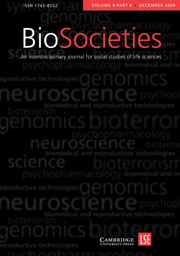Crossref Citations
This article has been cited by the following publications. This list is generated based on data provided by
Crossref.
Helmreich, Stefan
2008.
Species of Biocapital.
Science as Culture,
Vol. 17,
Issue. 4,
p.
463.
Delfanti, Alessandro
Castelfranchi, Yurij
and
Pitrelli, Nico
2009.
“What Dr Venter did on his holidays”: exploration, hacking, entrepreneurship in the narratives of theSorcerer IIexpedition.
New Genetics and Society,
Vol. 28,
Issue. 4,
p.
415.
Stevens, Hallam
2011.
On the means of bio-production: Bioinformatics and how to make knowledge in a high-throughput genomics laboratory.
BioSocieties,
Vol. 6,
Issue. 2,
p.
217.
Hodges, Matt
2012.
The politics of emergence: Public–private partnerships and the conflictive timescapes of apomixis technology development.
BioSocieties,
Vol. 7,
Issue. 1,
p.
23.
Birch, Kean
and
Tyfield, David
2013.
Theorizing the Bioeconomy.
Science, Technology, & Human Values,
Vol. 38,
Issue. 3,
p.
299.
Shewry, Teresa
2013.
Sea of secrets: Imagining illicit fishing in Robert Barclay’sMeļaļand Rob Stewart’sSharkwater.
Journal of Postcolonial Writing,
Vol. 49,
Issue. 1,
p.
47.
Hodges, Matt
2014.
1 Immanent anthropology: a comparative study of ‘process’ in contemporary France.
Journal of the Royal Anthropological Institute,
Vol. 20,
Issue. S1,
p.
33.
Jönsson, Erik
2016.
Benevolent technotopias and hitherto unimaginable meats: Tracing the promises of in vitro meat.
Social Studies of Science,
Vol. 46,
Issue. 5,
p.
725.
2017.
The Economization of Life.
p.
179.
Birch, Kean
2017.
The problem of bio-concepts: biopolitics, bio-economy and the political economy of nothing.
Cultural Studies of Science Education,
Vol. 12,
Issue. 4,
p.
915.
Vertommen, Sigrid
2017.
From the pergonal project to Kadimastem: A genealogy of Israel’s reproductive-industrial complex.
BioSocieties,
Vol. 12,
Issue. 2,
p.
282.
Levain, Alix
2017.
Hǔtái, une sortie de l’insignifiance.
Techniques & culture,
p.
66.
Rieppel, Lukas
Lean, Eugenia
and
Deringer, William
2018.
Introduction: The Entangled Histories of Science and Capitalism.
Osiris,
Vol. 33,
Issue. 1,
p.
1.
Helmreich, Stefan
and
Labruto, Nicole
2018.
The Palgrave Handbook of Biology and Society.
p.
851.
Gowdy, John
and
Baveye, Philippe
2019.
Agroecosystem Diversity.
p.
425.
Brugidou, Jeremie
and
Clouette, Fabien
2021.
Habiter les abysses ?.
Techniques & culture,
Guthman, Julie
and
Biltekoff, Charlotte
2021.
Magical disruption? Alternative protein and the promise of de-materialization.
Environment and Planning E: Nature and Space,
Vol. 4,
Issue. 4,
p.
1583.
Walford, Antonia
2021.
Data – ova – gene – data.
Journal of the Royal Anthropological Institute,
Vol. 27,
Issue. S1,
p.
127.
Kanoi, Lav
Koh, Vanessa
Lim, Al
Yamada, Shoko
and
Dove, Michael R
2022.
‘What is infrastructure? What does it do?’: anthropological perspectives on the workings of infrastructure(s).
Environmental Research: Infrastructure and Sustainability,
Vol. 2,
Issue. 1,
p.
012002.
Germond‐Duret, Celine
2022.
Framing the Blue Economy: Placelessness, Development and Sustainability.
Development and Change,
Vol. 53,
Issue. 2,
p.
308.


